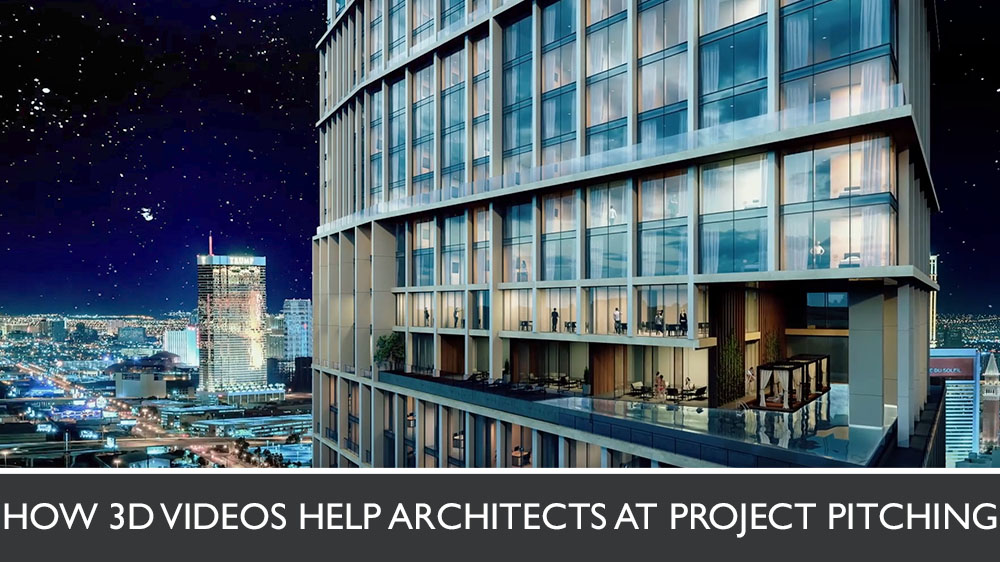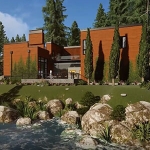Skilled architects have dozens of great works in their portfolios and are masters of their craft. However, getting new projects approved can be a difficult task even for a seasoned expert. It is not easy to explain an architecture project with the help of schematic drawings to stakeholders who most often cannot read them properly. This means that the investors can reject even the most brilliant design just because they do not understand all its benefits. Which will be a big disappointment for an architect who poured their heart and soul in the project.
So, how to convince stakeholders that the architectural design is totally worth the investment? It requires good rhetoric skills and a well-ordered plan of a presentation. And most important, it is impossible without powerful visual tools. That’s where a CGI architectural animation studio can be of great help. It can arm architects with the right tool — a 3D architectural video presentation. But why CGI videos are the best solution for pitching designs to stakeholders? There are several objective reasons for that. Let’s explore why a 3D animation is a key to winning over investors!
#1. CG videos help emphasize the selling points of a project
The stakeholders consider numerous projects and pick only the best ones. At the selection stage, they have to examine many sketches, blueprints, and spreadsheets with projected costs. All these materials are schematic and look pretty much the same. To stand out among competitors and instantly draw the investors’ attention, an architect has to submit something more impressive. They need to show a presentation that features all the selling points prominently, in a fresh and attractive way. It is a difficult task for schematic drawings and even static 3D visuals. And this is where CGI animation services can provide architects with a key to success.
A 3D architectural video presentation is capable of featuring all selling points exactly like the author of the project envisioned them. If it’s the high-end materials used for construction, 3D modeling and rendering software can accurately simulate wood, stone, brick, glass, and metals for the CG video. If the location is the thing that is supposed to wow the audience, the building can be shown in its expected context in photoreal quality. In the case it is needed to highlight the sophisticated architecture of the facade, a 3D video presentation can do it through close-up views. As a 3D animation is a movie, it shows everything in motion, giving the audience a life-like experience. With such a presentation, an architect can easily show stakeholders why exactly their investment will bear fruit in the future.
#2. CG videos impress the audience with cinematography techniques
Another great thing about a 3D animation presentation is the medium itself. A static CGI shot or a photograph leaves a lot of things to the imagination, while a movie can show every nook and cranny of a building from multiple perspectives and in motion.
It’s also worth mentioning that the right combination of cinematography techniques, such as dramatic POVs, time-lapses and bird’s-eye view flyovers, can drastically affect the way viewers perceive the project. On top of that, a 3D architectural video presentation can feature a specifically chosen soundtrack to better convey the mood of the future space. This kind of Hollywood-like magic would certainly impress even the pickiest of investors!
#3. A CG animation masterfully conveys the atmosphere of the future building
One of the great techniques to convince stakeholders is to demonstrate future property’s potential by showing it “in use”, so to speak. This method can be used for any kind of project. A 3D animation can showcase a lively holiday village, a bustling mall, a packed storefront with passers-by, a restaurant at rush hour, and so on.
At the pitching stage, it is impossible to showcase such scenes with photos, since the property doesn’t exist yet. So, CGI is the only viable option for this. And a 3D architectural video presentation is the best of all 3D visualization tools for conveying the atmosphere. The movement makes everything look natural as if the viewer is experiencing what it’s like to be there. So, the potential sponsors will be able to drink in the unique feel of the exterior or interior much better than by looking at even the most professional photos and still 3D renders.
To establish an atmosphere in 3D videos, a good CGI studio has vast libraries of tools and assets, making any sort of scenario possible. That includes placing a photoreal 3D model of the future building in its intended location and adding contextual elements, such as cars, well-kempt hedgerows, people, and so on. When stakeholders see the potential of the project in a 3D architectural video presentation, they will be more likely to get it approved.
#4. CG animations show that the building fits its surroundings
The architectural design itself may be a masterpiece, but the location is just as important. The new building must be in perfect harmony with the natural landscape and other architecture objects around. So, the stakeholders need to understand how well the structure fits its surroundings. Drawings and verbal explanations won’t be able to convey this crucial information. And this is where a CG animation comes to the rescue.
Seasoned 3D artists can masterfully recreate any scenes digitally — both rural and urban. Or, they can even use footage of a future building’s location shot from a drone to create a 3D movie. So, with a bit of adjustment, the environment in the 3D architectural video presentation will look exactly like the real place. The viewers will be able to see how well the exterior fits the location from multiple perspectives and in motion. On top of that, commercial and residential lots would look much more alluring to potential investors with infrastructure demonstration. The road network, access points, amenities — all on the screen, understandable with no words. As a bonus, the structure can be shown at different times of the day and under various weather conditions.
#5. A 3D architectural video presentation can be held as effectively online as offline
Sometimes stakeholders may be unable to attend a real-life presentation. Perhaps they are too busy at the moment, or too far away to get to the architect’s office. In that case, they might opt to attend online pitching. And here a photorealistic 3D film has a superb advantage over other presentation materials. It would be much easier to just play a video during a Skype call or a Google Hangout than explain everything with complicated blueprints. A CG movie can be opened and viewed on a large screen, a laptop at home or even on a smartphone.
This way, CGI not only makes architects prepared for any kind of design pitch. It also lets investors take their time and rewatch a 3D video after the pitching. So, they will be able to evaluate the project when they are most comfortable with it, making the decision when they want to.
Getting exterior or interior design projects approved can be challenging for architecture specialists. But with appropriate tools, it becomes easier and chances of success increase drastically. A 3D architectural video presentation is the right option to achieve this. Instead of schematic blueprints and explanations, the audience is treated to a cinematic masterpiece that presents the future building in all its glory, with a matching soundtrack and masterful editing. A 3D movie convinces investors, emphasizing all the selling points of property concisely and comprehensively. And if the sponsors need some time to drink the experience in, they can watch the video file again after the presentation from any device, online or offline.
Want to make the communication with your potential investors easier than ever? Make projects pitching a piece of cake with our professional architectural animation services!





Leave a Reply
Want to join the discussion?Feel free to contribute!